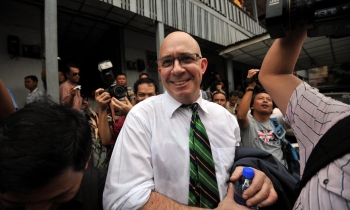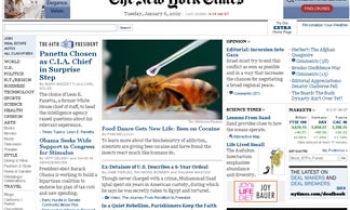Leading forecasters of advertising spending have turned cautious in their predictions for most media, except - not surprisingly - the Internet.
In a series of presentations yesterday, at the opening sessions of the 33rd annual UBS Global Media Conference in Midtown Manhattan, several analysts trimmed or stood pat on their growth estimates for this year and next.
Even some forecasters who were not presenting at the conference used it as a springboard to release predictions in which they also took another look at their previous growth forecasts.
Advertising spending is considered a gauge of the health of the economy, so the widespread predictions of cutbacks may augur some softness ahead. That may be tempered, however, by the unanimously robust estimates for growth in ad spending online, a category that for many analysts also includes new technologies like video-on-demand and broadband.
Indeed, two presentations on ad spending in newspapers sought to temper the present gloomy outlook for the industry by shining a spotlight on the strong demand for ad space on many newspaper Web sites.
The reasons the forecasters cited for their caution included expectations of slower spending by marketers in major categories like automobiles; increasingly unpredictable consumer behavior related to factors like the war in Iraq and the aftermath of Hurricanes Katrina and Rita; a lag in spending in local media; and the moving of dollars into the online media, with relatively lower out-of-pocket costs compared with traditional media like television.
In a presentation, Robert J. Coen, senior vice president and forecasting director at Universal McCann, lowered his estimate of United States ad spending for 2005 to a gain of 4.6 percent from 2004. That compared with a gain of 6.4 percent he predicted in December 2004 and a gain of 5.7 percent he predicted last June. By comparison, ad spending in the United States last year rose 7.4 percent from 2003.
Ad spending this year has "stalled, despite a pretty good economy," said Mr. Coen, who has been on the job since 1948 and is considered the dean of forecasters. He attributed the shortfall to "a pretty meager increase" in local ad spending from 2004, projected at only 2.3 percent, along with a reluctance among big national advertisers to keep opening their wallets ever wider.
Mr. Coen was slightly more optimistic about next year, leaving intact a prediction he made last June that United States ad spending in 2006 would rise 5.8 percent from 2005. He attributed the outlook to campaigns tied to the 2006 Winter Olympics as well as the significant spending likely to accompany the Congressional elections next fall.
"It should be a pretty good year for the advertising industry" domestically, Mr. Coen said, though "not quite as strong" as would warrant an increase in his 2006 forecast. Universal McCann is part of the McCann Worldgroup unit of the Interpublic Group of Companies.
Another leading forecaster, Steve King, worldwide chief executive at ZenithOptimedia, part of the Publicis Groupe, reduced his estimates for ad spending in the United States for this year and next.
Mr. King cut his growth forecast for 2005 to 2.9 percent over 2004 from a previous estimate of 3.6 percent, citing the retarding effects of the recovery from the hurricanes along with higher oil prices. He also cut his forecast for 2006 to a gain of 5.1 percent from 2005 compared with his previous forecast for a gain of 5.7 percent.
In the Internet category, however, Mr. King predicted a 15 percent increase in 2005 compared with 2004 and a 22 percent increase in 2006 compared with 2005.
"Even more conservative advertisers are starting to use it regularly," Mr. King said of the online medium, "as part of their marketing mix."
By contrast, in the newspaper category, Mr. King forecast a gain of 3.5 percent in 2005 compared with 2004 and a gain of 3 percent in 2006 compared with 2005.
In the newspaper presentation, James Conaghan of the Newspaper Association of America and Miles E. Groves of MG Strategic Research stressed the halo effects that ads appearing on Web sites are having on the revenue streams of the parents.
For 2005, Mr. Conaghan, vice president for business analysis and research at the association, predicted that newspaper ad spending would increase 3.2 percent from 2004 despite a decline in national ad spending of 2 percent and slow growth in other categories like retail and classifieds. The reason would be a 29.5 percent increase in online ad spending from last year.
There is a similar effect in his forecast for 2006. Newspaper ad spending will rise 4 percent from 2005, Mr. Conaghan said, because of a 25.1 percent gain in online ad spending from 2005.
Online ad spending, which composes 3 percent to 5 percent of total newspaper ad spending, "could reach 10 percent to 15 percent within the next several years," Mr. Conaghan predicted.
In his presentation, Mr. Groves, president and media economist at MG Strategic Research, forecast identical 3.4 percent increases for newspaper ad spending in 2005 compared with 2004 and in 2006 compared with 2005.
In both instances, the gains were bolstered substantially by the huge increases he predicted in ad spending on newspaper Web sites: up 40 percent in 2005 compared with 2004 and up 31.2 percent in 2006 compared with 2005.
That said, Mr. Groves expressed concern that the growth in online ad spending being enjoyed by newspapers could be threatened by "growth in Internet competitors in local markets" like Google and Craigslist, as the rivals siphon classified ad revenue.
The Craigslist Web site (craigslist.com) "is a pretty ugly thing to look at," Mr. Groves said, "but it works."
In a separate presentation, David F. Poltrack, executive vice president for research and planning at the CBS Television Network unit of Viacom, reduced a forecast he made last year for ad spending in 2005 on the four big broadcasters, including CBS.
Mr. Poltrack trimmed his estimate for an increase of 2.5 percent compared with 2004 to an increase of 1.5 percent. His forecast for 2006, however, calls for a gain of 7 percent from 2005, partly because of the revenue being added by the Winter Games, to be broadcast by NBC.
Mr. Poltrack also held out hope that broadcasters could derive revenue from nonadvertising sources as a result of opportunities provided by the new media.
In an experiment CBS conducted among viewers with digital cable, satellite and broadband, 95 percent said they would be interested in buying episodes of popular TV series as video-on-demand, Mr. Poltrack said.
And among those expressing an interest, Mr. Poltrack said, there was an even division between paying $1 an episode if commercials were omitted and paying 50 cents an episode if spots were included.
One forecaster not presenting at the conference who also reduced ad-spending estimates was Lauren Rich Fine, an analyst at Merrill Lynch.
Ms. Fine reduced her forecast for 2005 to a gain of 3.2 percent from 2004, compared with her previous estimate of a gain of 3.7 percent. For 2006, she lowered her forecast to an increase of 4.5 percent from 2005. That compared with her previous estimate for an increase of 5.2 percent.
Ms. Fine attributed the changes to softness in large categories like autos and entertainment.
Another forecaster not presenting at the conference, Leland Westerfield of Harris Nesbitt, said he would stand pat with his forecasts for a 4.4 percent increase in 2005 compared with 2004 and a 6.9 percent increase in 2006 compared with 2005.
Fueling his predicted gains: estimates that Internet ad spending will grow 31 percent in 2005 compared with 2004 and increase 37 percent in 2006 compared with 2005.









